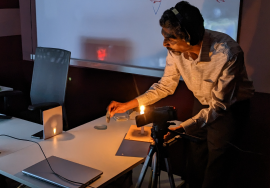Bridging The Educational Divide: Empowering Underprivileged Children Through Technology

Introduction:
Technology has emerged as a powerful tool in transforming education, particularly in underprivileged government schools. By embracing digital advancements, Connecting The Dots is aiming at bridging the educational divide and provide quality learning experiences to children who need it the most. This article focuses on the implementation of technology and Content Management Systems (CMS) in government schools, highlighting their potential to empower underprivileged students and revolutionize their educational journey.

Democratizing Education:
a) Access to Quality Teachers:
Through projectors, CTD conducts live classes to hundreds of classrooms and give underprivileged children access to expert teachers that display interactive and visually appealing content, making learning more enjoyable for them. Through our visual aids we are able to help simplify complex concepts, enhance understanding, and boost retention rates.
b) Fostering Collaborative Learning:
Our teachers are specially trained to facilitate collaborative learning environments, allowing students from diverse backgrounds to share ideas and participate actively. The classes allow two-way interaction, and this ensures immediate clarification of questions We also teach using live experiments and demonstrations given these children access to learning environments they would other wise not have had through their schools limited resources.
c) Real-World Experiences:
Underprivileged children often lack exposure to real-world scenarios. Our teachers try to create immersive learning experiences by showcasing real-life simulations, live experiments and demonstrations, giving these children access to learning environments they would other wise not have had through their schools limited resources. . This empowers students to think critically, problem-solve, and prepares them for future challenges.

Streamlining Classroom Management With LMS Systems:
Learning Management Systems (LMS) plays a crucial role in streamlining administrative and instructional processes in underprivileged government schools. The following points highlight a few of the many features in our custom LMS system Cloud-Tutors:
- Access to live & Interactive classes taken by highly qualified teachers
- Real-time monitoring of a student’s progress at school
- Access to an expansive content library with 2`000 hours of recorded classes
- Topic-wise Exam Practice papers & Worksheets with Solution Key
Benefits Of Implementing An LMS System In A Rural School:
a) Efficient Content Delivery:
LMS systems enable teachers to organize and deliver educational resources efficiently, saving time on administrative tasks. This ensures that teachers & students have access to our learning materials, assignments, and study resources conveniently.
b) Personalized Learning Opportunities:
Cloud-Tutors empower teachers to personalize learning experiences for each of their students. By tailoring assignments, quizzes, and learning paths, educators can address individual needs and provide targeted support, fostering academic growth.
c) Data-Driven Insights:
Cloud-Tutors generate valuable data on a students’ performance, enabling our project coordinators & teachers to analyze trends and identify areas of improvement. These insights help design effective teaching strategies, interventions, and support systems to enhance the educational outcomes.
Enabling Remote And Blended Learning Opportunities:
Enabling Remote And Blended Learning Opportunities:
Seamless Remote Learning:
Projectors and CMS systems like Cloud-Tutors ensure uninterrupted learning for underprivileged children, regardless of their physical location. Teachers can conduct interactive virtual classes, and CMS platforms serve as centralized hubs for communication, content delivery, and assessment.
Bridging the Gap through Blended Learning:
Students can now access online resources, videos, and interactive content, enriching their learning experiences. Blended learning models like ours combine traditional classroom methods with digital tools to create inclusive and comprehensive educational environments that benefit the students and empower the teachers in Government schools.

Conclusion
By implementing projectors and Content Management Systems (CMS), underprivileged government schools can empower children with quality education and bridge the educational divide. These technologies enhance visual learning experiences, streamline classroom management, and enable remote and blended learning opportunities. It is imperative for governments and organizations to prioritize the digital transformation of underprivileged schools, providing equal access to educational resources and creating a brighter future for these deserving students.






